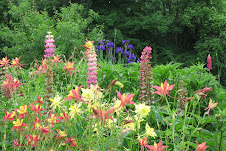We at Mosswood Gardens grow all of our own plants. This is not to say that every one of them is started from seed, as this is not always the easiest or most expeditious place to start. In many cases, growing from seed may not even be an option, as many of the beautifully colored and disease-resistant strains of plants such as geraniums or chrysanthemums are only available to us as cuttings.
Propagation, or the creation of new plants from an original plant, can be accomplished in a number of different ways. The most common methods used by the average home gardener are division or by sowing seeds. Seeds may be collected from many plants from their flower heads, after they have bloomed, or in the form of pods or berries.
Another method is to plant bulbs, tubers, rhizomes, or corms, which are treated similarly but are not the same thing (the difference between these terms will be the subject of a different article). These underground growths store the food the plant will need in order to grow in successive years. As the plant matures, the storage tanks begin to produce smaller offshoots that may be divided or separated from the parent and planted intheir own right. In the case of flowers like tulips or daylilies, such separation is essential to prevent overcrowding and ensure continued future blooms.
When it comes to plants with woodier stems, propagation is usually achieved by taking cuttings. In this method, a short section of an actively growing portion of the plant is cut from the parent, usually at a diagonal to create the maximum rooting surface area, after which it is treated with a rooting hormone and placed in a rooting medium such as moist sand (more on cuttings in a future article).
Another propagation technique is called layering. This may be accomplished in one of two ways. The traditional method is to stake down branches, vines, or canes, so that they are partially covered with soil at a distance from the parent plant. Over time, they will begin to produce their own roots, at which point they may be severed from the parent and planted independently. An alternative method, called air layering, is to cut partially through a branch, vine, cane, or stem, apply a rooting hormone, and then affixing a plastic bag containing a rooting medium over the cut.
Regardless of how a plant is propagated, home gardeners (and especially nurseries and garden centers) who do not first do a little research into the original plant may be inadvertently breaking the law. Many of the fabulous new colors and strains of plants that have been developed and brought to the market are patented and their propagation by any technique is prohibited without a specific license. Nurseries who seek to offer these plants must pay royalty fees, most often on purchased rooted or unrooted cuttings that they intend to grow on for the consumer. These fees go to support the vast amounts of time and painstaking research that went into the development of the new plant variety, so that scientists and growers may continue in their efforts to introduce exciting new strains for growers, producers, and home gardeners.
While it is unlikely that the typical home gardener will be visited by the "patent police," it is ultimately in their best interest to avoid propagating patented plants, which undermines the work that goes into plant research and can compromise the market. In the case of seed, efforts to propagate patented plants may even be an exercise in frustrating and time-consuming futility, as some of these plants are bred to have sterile seed. Even where the seed is not sterile, the offspring of the parent plant frequently bears little, if any, resemblance to the parent.
Thus, despite the somewhat hefty price tag even for us, just as we are dedicated to promoting fair trade in our gift shop, we at Mosswood Gardens are proud to showcase the most beautiful and improved varieties of plants available, and encourage our customers to support the work of plant developers so that we may continue to bring you the most luscious new plants on the market.
Tuesday, March 4, 2008
Subscribe to:
Post Comments (Atom)

No comments:
Post a Comment